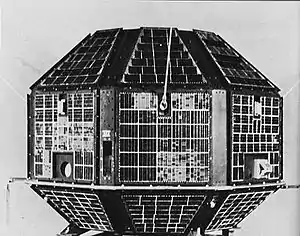IRS-P3
IRS-P3 was an Earth observation mission launched under the National Natural Resources Management System (NNRMS) programme undertaken by Indian Space Research Organisation (ISRO). The objectives of the mission was processing and interpretation of data generated by its two payloads, the Wide Field Sensor (WiFS) and Modular Opto-electric Sensor (MOS), developed by the German Aerospace Center.[1]
| Mission type | Earth Observation, Remote Sensing |
|---|---|
| Operator | ISRO |
| COSPAR ID | 1996-017A |
| SATCAT no. | 23827 |
| Website | https://www.isro.gov.in/Spacecraft/irs-p3 |
| Mission duration | 9 years and 10 months |
| Spacecraft properties | |
| Bus | IRS-P2 |
| Manufacturer | ISRO |
| Launch mass | 920 kg |
| Power | 817 watts |
| Start of mission | |
| Launch date | 21 March 1996, 04:53:00 UTC |
| Rocket | PSLV-D3 |
| Launch site | Sriharikota, FLP |
| Contractor | ISRO |
| End of mission | |
| Last contact | January 2006 |
| Orbital parameters | |
| Reference system | Geocentric |
| Regime | Sun-synchronous |
| Perigee altitude | 802 km |
| Apogee altitude | 848 km |
| Inclination | 98.69° |
| Period | 101.4 minutes |
| Epoch | 21 March 1996 |
History
IRS-P3 was remote sensing satellite launched by ISRO on board of Polar Satellite Launch Vehicle (PSLV) rocket for remote sensing of Earth's natural resources. It also hosted a scientific payload, Indian X-ray Astronomy Experiment (IXAE), for the study of X-ray astronomy. The IRS-P3 satellite contained an X-ray astronomy payload, a C-band transponder and two remote sensing payloads. IRS-P3 was one of the satellite in the Indian Remote Sensing Programme of Earth Observation satellites, assembled, launched and maintained by Indian Space Research Organisation. There was no data recording device on board of the IRS-P3 and data was transmitted in real-time to the ground stations in Hyderabad (India) and Neustrelitz (Germany).[2]
Payloads
IRS-P3 carried two remote sensing payloads and one X-ray astronomy:
- Wide Field sensor (WiFS) with additional Short Wave Infrared band (SWIR). The sensor was designed for vegetation dynamic studies.
- Modular Opto-electronic Scanner (MOS) [3] which was provided by German Aerospace Center (DLR), Germany in the framework of a cooperative agreement between ISRO and DLR.[4][5] MOS was designed for ocean remote sensing.[6][7]
- Indian X-ray Astronomy Experiment (IXAE). IXAE was to study the time variability and spectral characteristics of cosmic X-ray sources and for detection of transient X-ray sources. The experiment was developed by ISRO Satellite Centre (ISAC) and Tata Institute for Fundamental Research (TIFR). The experiment was intended to study periodic and aperiodic intensity variation in galactic/extragalactic X-ray, spectral characteristics of various sources and properties of newly discovered X-ray transients. IXAE instruments consisted of three identical pointed mode proportional counters (PPCs) operated in the energy range 2-20 keV, FOV of 2° x 2° and effective area of 1200 cm2, and an X-ray sky monitor (XSM) operating in the energy range 2-10 keV.[8]
Mission
IRS-P3 was launched by the PSLV-D3 launcher on 21 March 1996 from SHAR Centre, Sriharikota, India. Periodic calibration of PSLV tracking radar located at tracking stations.
The mission was completed in January 2006 after serving for 9 years and 10 months.[4] With the consecutive successful launches of the PSLV, it was decided not to plan any more ASLV missions.[9]
See also
References
- "MOS - A spaceborne imaging spectrometer for ocean remote sensing". ioccg.org. Retrieved 2 February 2013.
- "International Ocean Colour Coordinating Group (IOCCG)".
- "IRS-P3". isro.org. Retrieved 2 February 2013.
- IRS-P3
- "ESA EarthNet Online".
- "Science Direct". Bibcode:1996AcAau..39..711T. doi:10.1016/S0094-5765(97)00053-2. Cite journal requires
|journal=(help) - "National Remote Sensing Centre (NSRC)".
- http://www.vssc.gov.in/VSSC_V4/index.php/74-general/1003-indian-x-ray-astronomy-exp-ixae
- "Space Yuga". Archived from the original on 7 February 2012. Retrieved 3 May 2013.
